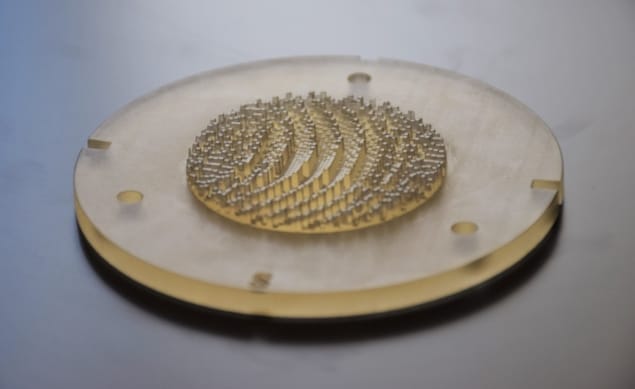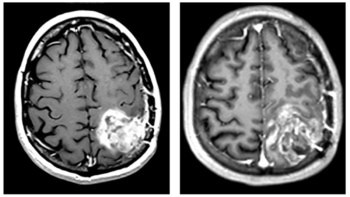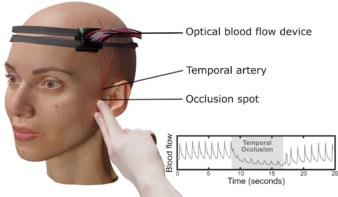
Three-dimensional printed acoustic lenses that focus ultrasound beams to arbitrary shapes within the brain have been developed by researchers at the Technical University of Valencia. The lenses correct for beam aberrations caused by ultrasound transmission through the skull, and can be custom made to suit the anatomy of each patient. A less expensive focusing method than phased arrays — the current state-of-the-art — the technique could allow new treatments that open the blood–brain barrier or alter nerve activity, as well as offering greater control over ultrasound-induced hyperthermia.
Therapeutic focused ultrasound is firmly established in the medical mainstream, finding use in the fragmentation of kidney stones and the thermal ablation of tumours. There are good clinical reasons for wanting to apply it to the brain, too, since here the technique can achieve some very specific effects. One of these is the penetration of the blood–brain barrier — a membrane that keeps the brain and central nervous system (CNS) largely isolated from the circulatory system, making it difficult to treat the brain with drugs. Another emerging application is the use of ultrasound to manipulate brain activity, allowing insights into neural dynamics and potentially leading to treatments for certain brain pathologies.
These applications require ultrasound energy to be delivered precisely to irregular volumes in the brain. The problem is, such fine control is hindered by the skull, which effectively sound-proofs the brain by reflecting, refracting and absorbing acoustic radiation. Acoustic lenses and phased arrays of ultrasonic transducers have been used to compensate for this effect, but these still produce a single focal point.
Now, in a paper posted on arXiv, Sergio Jiménez-Gambín and colleagues at the Institute of Instrumentation for Molecular Imaging have shown that bespoke acoustic holographic lenses can overcome the aberrating effect of the skull while simultaneously achieving complex irradiation geometries (arXiv:1902.06716v1).
First, the team used the results of publicly available X-ray CT and MRI scans to produce a computer model of a patient’s skull and brain. The X-ray absorption data from the CT scan gave the team an approximation of the skull’s acoustic parameters. The MRI data provided the shape and location of the hippocampus, which was to be the target for the procedure.

Next, the researchers simulated acoustic sources with various shapes and amplitudes inside the brain. They chose three configurations, corresponding to three different target geometries: a pair of point sources, one on each side of the hippocampus; a set of 50 point sources describing an arbitrary curve; and a volume encompassing the entire right side of the hippocampus.
Simulated sound waves propagating outward from these sources were transmitted through the skull, emerging with a characteristic phase and amplitude profile. Acoustic waves propagate in a way that is time-symmetric, so the specific lens design that would restore the exiting sound waves to uniformity was the very same design that, with time reversed, would serve to focus a pristine ultrasound beam to the required geometry in the brain.
Armed with the knowledge of the lens configurations that would form the desired irradiation patterns, the team realised the designs using a 3D printer, and tested them in a 3D-printed skull phantom. The measured pressure fields agreed closely with the model, and although the phantom’s acoustic properties did not perfectly match those of a real human skull, the researchers are confident from their simulations that the results will hold in more realistic situations.

Focused ultrasound opens the blood-brain barrier
Because each of these acoustic lenses is produced for a specific set of target and delivery geometries, the method lacks the real-time adaptability of phased-array systems, which can be employed with simultaneous image guidance. It does have other advantages, however.
“Ultrasound phased arrays guided by MRI allow ultrasonic energy to be focused in a very precise point deep in the brain,” says Noé Jiménez, who collaborated on the research. “However, if the desired target is not a point but a complex volume, several sonications are needed. This new technique using acoustic holograms allows the ultrasonic field to be adapted to the desired target volume, minimizing the treatment time and optimizing the ultrasonic energy into the region of interest.”



